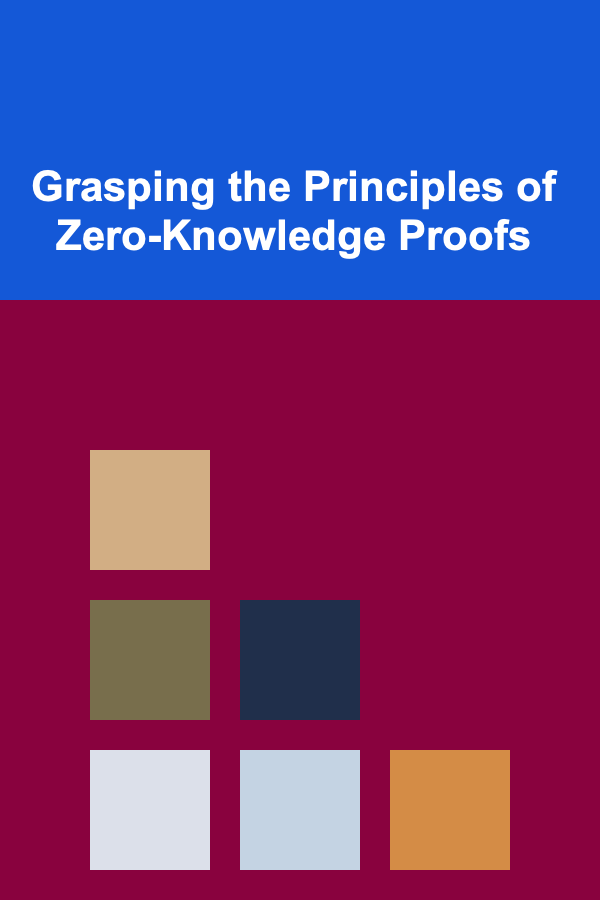
Grasping the Principles of Zero-Knowledge Proofs
ebook include PDF & Audio bundle (Micro Guide)
$12.99$10.99
Limited Time Offer! Order within the next:

Zero-knowledge proofs (ZKPs) are cryptographic protocols that allow one party (the prover) to convince another party (the verifier) that a statement is true without revealing any information beyond the validity of the statement itself. This seemingly paradoxical concept has profound implications for privacy, security, and scalability in various applications, from authentication and digital identity to decentralized finance and verifiable computation. Understanding the fundamental principles of ZKPs is crucial for anyone interested in building secure and privacy-preserving systems. This in-depth exploration will delve into the core concepts, essential properties, different types, and practical considerations of zero-knowledge proofs, ultimately providing a roadmap for grasping this powerful cryptographic tool.
The Core Concept: Proof Without Information
At its heart, a zero-knowledge proof achieves the impossible: it demonstrates knowledge without revealing the knowledge itself. Imagine Alice wants to convince Bob that she knows the solution to a difficult math problem, but she doesn't want to tell Bob the answer. A ZKP allows her to do exactly that. Bob will be convinced that Alice knows the solution, but he won't gain any information about the solution itself.
This is achieved through clever interactive protocols (although non-interactive ZKPs exist) where Alice and Bob engage in a series of exchanges. The protocol is designed in such a way that Alice's responses are only possible if she actually possesses the knowledge she claims to have. Bob, by carefully observing Alice's responses, can gain confidence in Alice's claim without learning anything about the knowledge itself.
The power of ZKPs lies in their ability to decouple knowledge from its revelation. You can prove you know something without actually revealing what you know.
Essential Properties of Zero-Knowledge Proofs
To be considered a true zero-knowledge proof, a protocol must satisfy three fundamental properties:
- Completeness: If the statement is true, an honest prover can convince an honest verifier that the statement is true. In other words, if Alice truly knows the answer, she can successfully convince Bob.
- Soundness: If the statement is false, no prover (even a dishonest one) can convince an honest verifier that the statement is true, except with negligible probability. This means if Alice doesn't know the answer, she can't fool Bob into believing she does (except by sheer luck, which can be made vanishingly small).
- Zero-Knowledge: If the statement is true, the verifier learns nothing beyond the fact that the statement is true. The verifier gains no information about the secret knowledge itself. This is the most crucial and challenging property to achieve.
It's important to note that the zero-knowledge property is often defined more formally using the concept of a simulator. A simulator is an algorithm that can generate a transcript of the interaction between the prover and the verifier without actually knowing the secret knowledge. If the verifier cannot distinguish between a real transcript generated by the actual interaction and a simulated transcript generated by the simulator, then the protocol is considered zero-knowledge. This guarantees that the verifier hasn't learned anything meaningful from the interaction, as everything they observed could have been created without any real knowledge.
Illustrative Examples: The Essence of ZKPs
To further clarify the concept, let's explore some classic examples of zero-knowledge proofs:
1. The Cave of Ali Baba (Interactive)
This is a classic and intuitive example. Imagine a cave with a circular tunnel. Alice knows a secret word that opens a door in the middle of the tunnel. Bob stands outside the cave entrance and wants to be convinced that Alice knows the secret word, but he doesn't want to learn the word himself.
The protocol works as follows:
- Alice enters the cave and walks either down path A or path B (Bob can't see which path she takes).
- Bob waits a while and then shouts into the cave: "Alice, come out on path A!" (He randomly chooses either path A or path B).
- If Alice went down the path Bob called out, she simply walks back to the entrance. If she went down the other path, she uses the secret word to open the door, crosses over, and walks back to the entrance.
This process is repeated many times. If Alice doesn't know the secret word, the probability that she can successfully complete this protocol multiple times (say, 20 times) by pure chance is extremely low (approximately (1/2)^20). Therefore, if Alice consistently follows Bob's instructions, Bob becomes convinced that she knows the secret word, without ever learning the word itself.
This example highlights the core principles of ZKPs:
- Completeness: If Alice knows the secret word, she can always satisfy Bob's request.
- Soundness: If Alice doesn't know the secret word, she has a small chance of guessing correctly each time, but this probability shrinks exponentially with each repetition.
- Zero-Knowledge: Bob only observes Alice appearing on the requested path. He learns nothing about the secret word itself. He doesn't see how she opens the door, nor does he gain any information that would help him discover the word.
2. The Map Coloring Problem (Interactive)
Consider a map where adjacent regions must be colored with different colors. Alice claims to know a valid coloring of the map using three colors. She wants to prove this to Bob without revealing the actual coloring.
The protocol:
- Alice randomly shuffles her color assignment (e.g., red becomes blue, blue becomes green, green becomes red). She then hides the colored map under sealed envelopes, one envelope per region.
- Bob randomly chooses a pair of adjacent regions and asks Alice to open the corresponding envelopes.
- Alice opens the chosen envelopes, revealing the colors of those two regions. Bob verifies that the colors are different.
This process is repeated multiple times with different random shufflings and choices of adjacent regions.
Analysis:
- Completeness: If Alice knows a valid coloring, she can always provide a valid pair of different colors.
- Soundness: If Alice doesn't know a valid coloring, there will be at least one pair of adjacent regions with the same color. The probability that Bob doesn't choose this pair in any given round is less than 1. After multiple rounds, the probability of a dishonest Alice successfully fooling Bob becomes negligible.
- Zero-Knowledge: Bob only sees the colors of two adjacent regions after they have been randomly shuffled. He learns nothing about the original coloring of the entire map. He only confirms that the adjacent regions are colored differently, which is consistent with the claim that a valid 3-coloring exists.
Types of Zero-Knowledge Proofs
Zero-knowledge proofs are a diverse field with various constructions offering different trade-offs in terms of efficiency, security assumptions, and applicability. Here's a brief overview of some prominent types:
1. Interactive vs. Non-Interactive Zero-Knowledge Proofs (IZK vs. NIZK)
- Interactive ZKPs (IZK): These proofs require direct interaction between the prover and the verifier, as seen in the Cave of Ali Baba and Map Coloring examples. The verifier sends challenges, and the prover responds accordingly.
- Non-Interactive ZKPs (NIZK): These proofs allow the prover to generate a proof that can be verified by anyone, without any further interaction. This is a significant advantage in many practical scenarios. NIZKs often rely on cryptographic assumptions such as the existence of common reference strings (CRS).
NIZKs are generally more desirable for applications where interaction is impractical or undesirable, such as in blockchain systems. However, they often come with more complex constructions and stronger security assumptions.
2. Specific-Purpose vs. General-Purpose ZKPs
- Specific-Purpose ZKPs: These are designed to prove the validity of a specific type of statement. The Cave of Ali Baba example is a specific-purpose ZKP for proving knowledge of a secret word.
- General-Purpose ZKPs: These are designed to prove the validity of a wide range of statements, often expressed as computational statements or mathematical relations. This is achieved through techniques like representing the computation as an arithmetic circuit and then constructing a proof for the correctness of the circuit evaluation.
General-purpose ZKPs are more versatile but typically less efficient than specific-purpose ZKPs. zk-SNARKs (described below) are a prominent example of general-purpose ZKPs.
3. zk-SNARKs, zk-STARKs, and Bulletproofs
These are three prominent families of zero-knowledge proof systems, each with its own characteristics and trade-offs:
- zk-SNARKs (Zero-Knowledge Succinct Non-Interactive Argument of Knowledge):
- Succinct: The proof size is very small, typically in the hundreds of bytes, regardless of the complexity of the statement being proven.
- Non-Interactive: The proof can be verified without any interaction between the prover and the verifier.
- Argument of Knowledge: It is computationally infeasible for a prover to create a valid proof without actually knowing the knowledge being proven.
- zk-SNARKs often rely on a trusted setup to generate a common reference string (CRS). The security of the system depends on the secrecy of the randomness used to generate the CRS. If this randomness is compromised, it becomes possible to generate fake proofs. Recent advancements are exploring ways to mitigate this risk through multi-party computation (MPC) ceremonies to generate the CRS in a distributed manner.
- Popular zk-SNARK constructions include Groth16, PLONK, and Marlin.
- zk-STARKs (Zero-Knowledge Scalable Transparent ARguments of Knowledge):
- Scalable: The prover and verifier time scales logarithmically with the size of the computation.
- Transparent: zk-STARKs do not require a trusted setup. They rely on publicly verifiable randomness for their security.
- Argument of Knowledge: Similar to zk-SNARKs, it is computationally infeasible for a prover to create a valid proof without knowing the knowledge being proven.
- zk-STARKs generally produce larger proofs than zk-SNARKs, but they offer stronger security guarantees due to the lack of a trusted setup.
- Bulletproofs:
- Bulletproofs offer a good balance between proof size and computational efficiency.
- They do not require a trusted setup.
- They are particularly well-suited for proving statements about aggregated data, such as ranges of values.
- The proof size scales logarithmically with the number of aggregated values, making them efficient for large datasets.
Practical Considerations and Challenges
While zero-knowledge proofs offer immense potential, there are also practical considerations and challenges to be aware of:
1. Computational Overhead
Generating and verifying zero-knowledge proofs can be computationally expensive, especially for complex statements. The choice of ZKP system depends heavily on the specific application and the acceptable trade-off between proof size, computational cost, and security assumptions.
2. Trusted Setup (for some ZKPs)
As mentioned earlier, some ZKP systems, such as zk-SNARKs, require a trusted setup to generate a common reference string (CRS). This introduces a potential vulnerability if the randomness used to generate the CRS is compromised. Mitigation strategies, such as MPC ceremonies, can help reduce this risk.
3. Complexity of Implementation
Implementing zero-knowledge proof systems can be complex and requires specialized knowledge in cryptography, mathematics, and programming. There are ongoing efforts to develop easier-to-use libraries and frameworks to simplify the implementation process.
4. Proof Size
The size of the generated proof can be a critical factor, especially in applications with limited bandwidth or storage. zk-SNARKs offer the smallest proof sizes, while zk-STARKs generally produce larger proofs. Bulletproofs offer a balance between size and efficiency.
5. Security Assumptions
The security of a zero-knowledge proof system relies on underlying cryptographic assumptions, such as the hardness of certain mathematical problems (e.g., discrete logarithm problem, elliptic curve cryptography). It's crucial to carefully evaluate the security assumptions and choose a ZKP system that provides adequate security for the intended application.
Applications of Zero-Knowledge Proofs
The applications of zero-knowledge proofs are vast and growing rapidly. Here are some notable examples:
1. Authentication and Digital Identity
ZKPs can be used for secure and privacy-preserving authentication. A user can prove that they possess certain credentials (e.g., age, membership) without revealing the actual credentials themselves. This is particularly useful for online services and applications where users want to protect their privacy.
2. Privacy-Preserving Payments
ZKPs are used in cryptocurrencies like Zcash to enable shielded transactions, where the sender, receiver, and transaction amount are hidden from public view. This provides a higher level of privacy compared to traditional cryptocurrencies like Bitcoin.
3. Verifiable Computation
ZKPs can be used to verify the correctness of computations performed by a remote or untrusted party. This is particularly useful for cloud computing and distributed computing, where it's important to ensure that computations are performed correctly without revealing the input data.
4. Decentralized Finance (DeFi)
ZKPs are being used in DeFi applications to improve privacy, scalability, and efficiency. Examples include private decentralized exchanges (DEXs), confidential voting systems, and secure lending platforms.
5. Secure Multi-Party Computation (MPC)
ZKPs can be combined with MPC techniques to enable secure computation on sensitive data held by multiple parties, without revealing the individual datasets to each other. This is useful for applications such as collaborative data analysis and secure machine learning.
6. Supply Chain Management
ZKPs can be used to verify the authenticity and provenance of products in a supply chain without revealing sensitive information about suppliers, manufacturers, and distributors.
Conclusion: Embracing the Power of Zero-Knowledge
Zero-knowledge proofs are a revolutionary cryptographic tool with the potential to transform various industries by enabling secure and privacy-preserving solutions. While the underlying mathematics and cryptography can be complex, understanding the core principles, essential properties, and different types of ZKPs is essential for anyone interested in leveraging their power.
As research and development in this field continue to advance, we can expect to see even more innovative applications of zero-knowledge proofs emerge in the future. By embracing the power of zero-knowledge, we can build a more secure, private, and trustworthy digital world.
To continue your exploration, consider delving deeper into specific ZKP constructions like Groth16, PLONK, and zk-STARKs. Experiment with ZKP libraries and frameworks to gain hands-on experience. Stay updated on the latest research and developments in this exciting and rapidly evolving field.

How to Create a Checklist for Evaluating Suppliers Before Restocking
Read More
How to Create a Financial Plan for a Single Parent Household
Read More
How to Design a Data Analysis Checklist for Cross-Validation of Results
Read More
How to Optimize Your Vehicle for Traveling with Pets
Read More
How To Build a Strong Esports Team
Read More
Leveraging Social Media for Community Building: A Comprehensive Guide
Read MoreOther Products

How to Create a Checklist for Evaluating Suppliers Before Restocking
Read More
How to Create a Financial Plan for a Single Parent Household
Read More
How to Design a Data Analysis Checklist for Cross-Validation of Results
Read More
How to Optimize Your Vehicle for Traveling with Pets
Read More
How To Build a Strong Esports Team
Read More